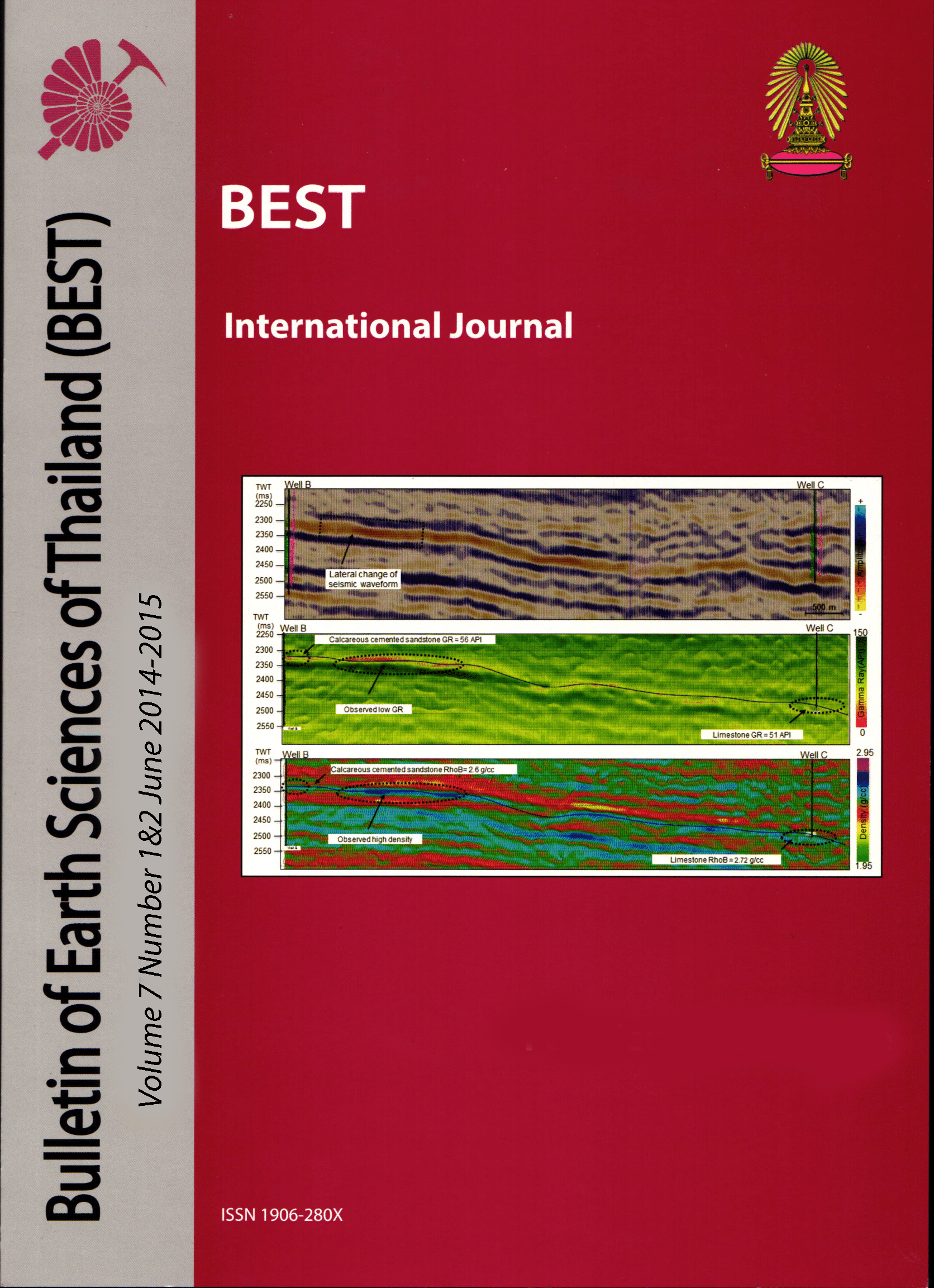Different Types of Organic-Rich Geological Markers in Surat, Central-North of Pattani Basin, Gulf of Thailand
Main Article Content
Abstract
The lower to middle Miocene organic-rich sediment in the Surat area, central Pattani Basin, Gulf of Thailand has been studied using conventional core with the integration of wireline and petrographical data. The results suggest three types of organic-rich sediments, which are non-marine coaly mudstone, marginal marine coaly mudstone, and estuarine shale. Non-marine coaly mudstone is indistinguishable from floodplain sediments on wireline due to their similar characteristics. Marginal marine coaly mudstone with abundant pyrite nodules has low density, and high gamma well-log characteristics and a widespread distribution. Thin estuarine shale is difficult to distinguish on wireline only, however; associated marginal marine coal with low resistivity and high gamma shale can be recognized and correlated. The other associated facies in the succession are interpreted as dominantly fluvial deposits with tidal influence. The recognition of estuarine shale suggests that major marine transgressions occurred in the lower and middle Miocene. The presence of a thin transgressive section indicates the low basinal slope of the Miocene of Pattani Basin allowed the marine shoreline to migrate to the central-north of the basin. The evidence of marine incursions provides a better understanding of the lower to middle Miocene stratigraphic framework in the Surat area and Pattani Basin, and it is an important controlling factor for possibly tide-influenced fluvial sand reservoirs in the southern area.
Article Details

This work is licensed under a Creative Commons Attribution-NonCommercial-NoDerivatives 4.0 International License.
Copyright © 2008 Department of Geology, Faculty of Science, Chulalongkorn University. Parts of an article can be photocopied or reproduced without prior written permission from the author(s), but due acknowledgments should be stated or cited accordingly.
References
Choi, K.S. and Dalrymple, R.W., et al., 2004, Sedimentology of modern, inclined heterolithic stratification (IHS) in the macrotidal Han River delta, Korea, Journal of Sedimentary Research, v. 74, p. 677-689.
Choy, S. C. and Booth, W. E., 1994, Prolonged inundation and ecological changes in an Avicennia mangrove: implications for conservation and management, Hydrobiologia 285(1-3): p. 237-247.
Crossley, A.R., 1990, The geology and hydrocarbon potential of the Pattani Basin Gulf of Thailand-An overview-: Unocal Thailand Internal Report, November 1990, 99 p.
Jardine, E., 1997, Dual petroleum systems governing the prolific Pattani Basin, off- shore Thailand, Proceedings of the Petroleum Systems of SE Asia and Australia Conference, Jakata, May 21-23, 1997, p. 351-363.
McCabe, P.J., 1984, Depositional models of coal and coal-bearing strata, in Rahmani, R.A., and Flores, R.M., eds., Sedimentology of coal and coalbearing sequences: International Association of Sedimentologists, Special Publication 7, p. 13-42.
Morley, C. K. and Westaway, R., 2006. Subsidence in the super-deep Pattani and Malay basins of Southeast Asia: a coupled model incorporating lower crustal flow in response to post-rift sediment loading. Basin Research, 18, 51–84.
Morley, C.K. and Racey A., 2011, Tertiary stratigraphy, Ridd, M. F., Barber A. J., and Crow M. J., eds., The Geology of Thailand : Geological Society of London, p. 223-271.
Narapan, J., 2015, Different types of organic-rich geological markers in South Pailin field, Pattani Basin, Gulf of Thailand, Master’s thesis, Chulalongkorn University, Bangkok, 51 p.
Trevena, A. S., 1991, Sedimentology and reservoir characteristics of cored intervals in Surat 5, 6, a-3 and a-4 wells, Gulf of Thailand: Unocal Corporation Science and Technology Division, Project report S&TD PR 91-33, 29 p.


